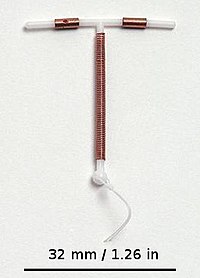
Photo from wikipedia
Abstract Introduction Intrauterine devices (IUDs) are good contraceptive method for women as they have a long acting contraceptive effect compared to other hormonal methods. Misoprostol or prostaglandin El (PGE1) analogue… Click to show full abstract
Abstract Introduction Intrauterine devices (IUDs) are good contraceptive method for women as they have a long acting contraceptive effect compared to other hormonal methods. Misoprostol or prostaglandin El (PGE1) analogue is a synthetic prostaglandin that has been used to induce cervical ripening in vaginal delivery and in medical induction of abortion. Sublingual administration of misoprostol has been shown to be more effective for cervical priming compared with oral administration and equally effective as vaginal administration. Objectives Pain assessment using both the numeric rating scale & pain visual analog scale. The secondary outcome was the successful IUD insertion without the use of adjunctive measures. Material and methods The study was a double blinded randomized controlled trial included 400 cases attended the family planning clinic in Shatby Maternity University Hospital, compared sublingual 200 μg misoprostol with placebo to facilitate IUD insertion. The following parameters have been also studied: • Misoprostol side effects within 48 h of intake: nausea, vomiting, fever, pain and bleeding. • Difficulty in IUD insertion. • Pain assessment using both the numeric rating scale & pain visual analog scale. • Failure of IUD insertion. Results Regarding the easiness of uterine sounding, there was no statistical difference between the two groups. The combined pain assessment was done using numerical rating scale recorded by the woman and VAS recorded by the health provider; the higher reading of both scales for each case was recorded and analyzed there was no statistical significant difference as regard pain reduction in using misoprostol prior to IUD insertion. As regards successful insertion of IUD, the calculated p value did not show any significant difference regarding using misoprostol for successful IUD insertion. The cumulative side effects reported in both groups showed that there is a significant statistical difference between both groups. Conclusion Although misoprostol is used in cervical ripening in labour induction and medical evacuation of missed abortion, its use to facilitate IUD insertion in women with tight cervix or in whom vaginal delivery was not experienced, has no role in pain reduction or increase the ease of IUD insertion.
Journal Title: Middle East Fertility Society Journal
Year Published: 2018
Link to full text (if available)
Share on Social Media: Sign Up to like & get
recommendations!